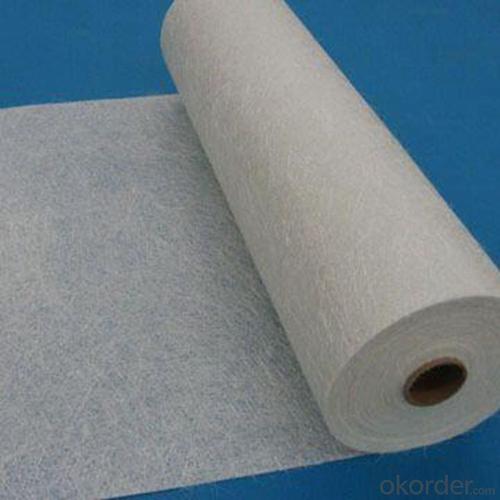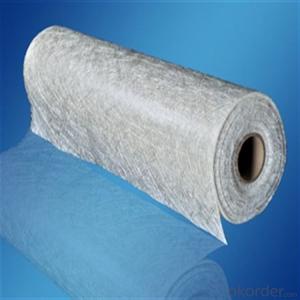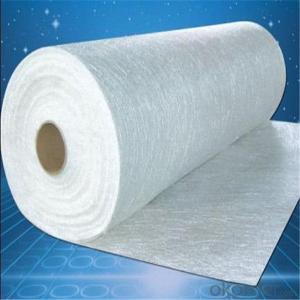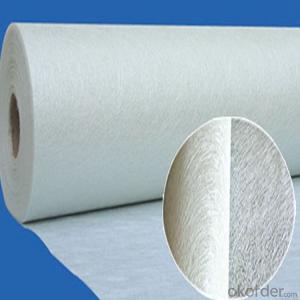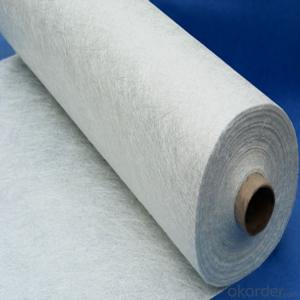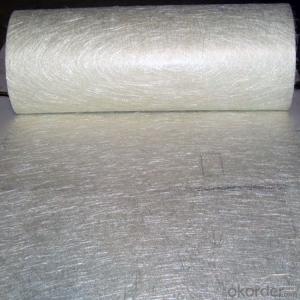Chop Strand Mat Fiberglass - E-Glass or C-Glass Fiber Reinforced Plastics
- Loading Port:
- China main port
- Payment Terms:
- TT OR LC
- Min Order Qty:
- 1 kg
- Supply Capability:
- 5000 kg/month
OKorder Service Pledge
OKorder Financial Service
You Might Also Like
Product Description:

Surfacing Tissue mainly used in the surface layers of FRP products. It features even Fiber distribution, soft feel, level and smooth fiber surface, less glue content, quick resin soak and good pattern fitness. It can improve the product surface property on corrosion resistance, compressive strength, seepage resistance, and longer service life. It is also suitable for spraying; pattern pressing and other FRP pattern technology.
Surfacing Tissue mainly used in the surface layers of FRP products. It features even Fiber distribution, soft feel, level and smooth fiber surface, less glue content, quick resin soak and good pattern fitness. It can improve the product surface property on corrosion resistance, compressive strength, seepage resistance, and longer service life. It is also suitable for spraying; pattern pressing and other FRP pattern technology.
Product Features:
Fast breakdown in styrene
Fiber dispersed evenly
Low binder content
Superior acid corrosion resistance
Specifications:
Item | Over Density | Moisture Content | Chop Density | Polyester Yarn | Width |
(g/m2) | (%) | (g/m2) | (g/m2) | (mm) | |
EMK300 | 309.5 | ≤0.15 | 300 | 9.5 | 50-3300 |
EMK380 | 399 | 380 | 19 | ||
EMK450 | 459.5 | 450 | 9.5 | ||
EMK450 | 469 | 450 | 19 | ||
EMC0020 | 620.9 | 601.9 | 19 | ||
EMC0030 | 909.5 | 900 | 9.5 |
Product Packaging:
Each Surface Tissue is wound onto a paper tube which has an inside diameter of 76mm and the mat roll has a diameter of 330mm. The mat roll is wrapped up with plastic film,and then packed in a cardboard box or wrapped up with kraft paper. The rolls can be vertically or horizontally placed. For transportation, the rolls can be loaded into a cantainer directly or on pallets.
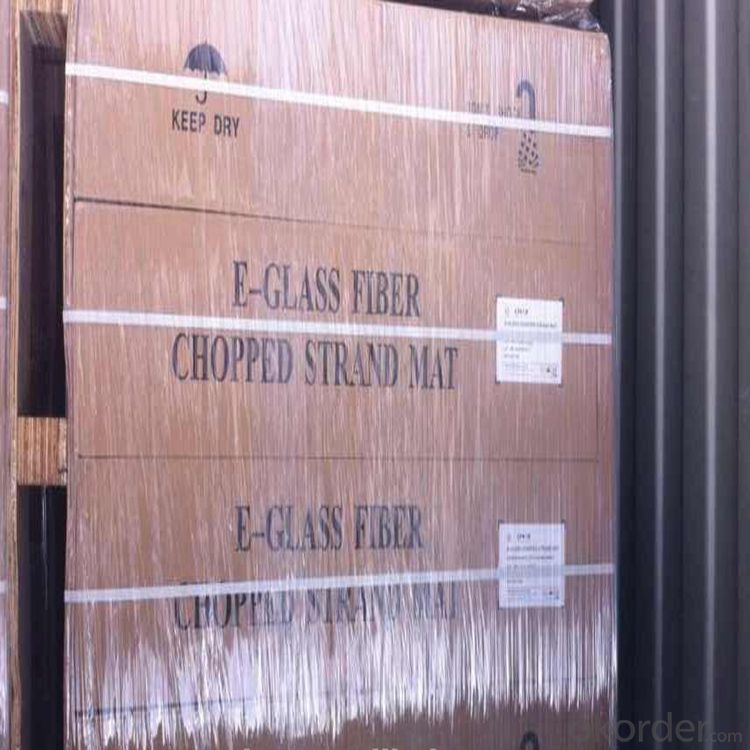
Product Storage:
Unless otherwise specified, Chopped Strand Mat should be stored in a dry, cool and rain-proof area. It is recommended that the room temperature and humidity should be always maintained at 15℃~35℃ and 50%~75% respectively.
Company Information
CNBM (China National Building Material) Group is the largest comprehensive building materials group in China that in integrate scientific research, manufacturing and logistics into one entity. The largest building materials and equipment specialists in China. Upon State Council approval, today CNBM owned more than 300 subordinate manufacturing factories and servicing companies. There are 6 fully owned public listed companies and 11 partially owned with substantial shares public listed companies. In many of these fields, CNBM is playing the leading role in the building industry in the country.

- Q: Is fiberglass chopped strand suitable for high-temperature applications?
- High-temperature applications are not typically suitable for fiberglass chopped strand. Despite its excellent strength and durability, fiberglass has limited resistance to high temperatures. In comparison to materials like carbon fiber or ceramic fibers, fiberglass has a relatively low melting point of around 1000°C (1832°F). When exposed to temperatures above its melting point, fiberglass can lose its structural integrity and degrade. This degradation can compromise its mechanical properties, resulting in reduced strength and stiffness. Moreover, the resin matrix within the fiberglass can degrade when subjected to high temperatures, leading to a loss of bond between the fibers and compromising the overall performance of the material. For high-temperature resistance, it is advisable to consider alternative materials specifically designed for such conditions. Ceramic fibers, for instance, are renowned for their excellent thermal stability and ability to withstand much higher temperatures than fiberglass. Carbon fiber composites can also be suitable for high-temperature applications, as they exhibit good thermal resistance and mechanical properties at elevated temperatures. Ultimately, the choice of material for high-temperature applications should depend on the specific temperature range and performance requirements of the application. Consulting with materials experts or experienced engineers in high-temperature materials is crucial to ensure the selection of the most suitable material for the intended use.
- Q: How does the fiber length affect the performance of fiberglass chopped strand?
- The performance of fiberglass chopped strand is greatly influenced by the length of its fibers. Generally, longer fibers result in better mechanical properties, such as increased strength and stiffness. This is because longer fibers have the ability to transfer loads more effectively, allowing them to bear higher loads without breaking or deforming. In industries like automotive and aerospace, where strength and rigidity are of utmost importance, longer fiber lengths are preferred. They offer improved resistance against deformation, impact, and fatigue, thereby increasing the durability and reliability of the material. Furthermore, longer fibers also enhance the bonding between the fiber and the matrix material, leading to better distribution of load and transfer of stress. As a result, overall performance is enhanced, especially in terms of tensile strength and impact resistance. However, it is worth noting that there is a limit to the length of the fibers beyond which the benefits start to diminish. Extremely long fibers can cause processing difficulties and uneven dispersion within the matrix. This can have a negative impact on the material's mechanical properties, ultimately leading to a decrease in performance. To summarize, the performance of fiberglass chopped strand is directly affected by the length of its fibers. Longer fibers improve strength, rigidity, and overall mechanical properties, making them suitable for demanding applications. However, finding the right balance between fiber length and processability is crucial to achieve optimal performance.
- Q: Is fiberglass chopped strand suitable for automotive applications?
- Fiberglass chopped strand is indeed suitable for automotive applications. This versatile material brings numerous advantages to automotive manufacturers. Its lightweight nature, coupled with its strength and durability, makes it the perfect choice for reducing vehicle weight while maintaining structural integrity. Automotive components such as body panels, interior trim, and underbody shields can all benefit from the use of fiberglass chopped strand. It offers outstanding resistance to corrosion, chemicals, and heat, ensuring that it performs exceptionally well in demanding automotive environments. Moreover, its ability to be easily molded into intricate shapes allows for design flexibility and customization. In conclusion, fiberglass chopped strand is a dependable and cost-effective solution for automotive applications.
- Q: How is fiberglass chopped strand incorporated into products?
- Fiberglass chopped strand is commonly incorporated into products by mixing it with a resin or adhesive, and then applying it to a surface or molding it into a desired shape. The chopped strands provide reinforcement and strength to the final product, making it more durable and resistant to damage.
- Q: What are the creep resistance properties of fiberglass chopped strand?
- Fiberglass chopped strand has excellent creep resistance properties. Its high strength and stiffness allow it to withstand long-term exposure to stress or load without significant deformation or creep. This makes it a preferred material for applications where dimensional stability and resistance to creep are important, such as in automotive components, construction materials, and aerospace structures.
- Q: Is fiberglass chopped strand suitable for the production of automotive components?
- Yes, fiberglass chopped strand is suitable for the production of automotive components. It offers excellent strength and stiffness properties, as well as high impact resistance. Additionally, it is lightweight, corrosion-resistant, and cost-effective, making it a popular choice for various automotive applications such as body panels, interior parts, and structural components.
- Q: Can fiberglass chopped strand be used in electrical transformers?
- Typically, fiberglass chopped strand is not utilized in electrical transformers. For electrical transformers, materials with high electrical conductivity and low magnetic permeability, such as copper or aluminum, are required. In contrast, fiberglass is commonly employed as an insulating material due to its notable strength and resistance to heat and chemicals. Although fiberglass may be appropriate for other applications in electrical systems, it is not the preferred choice for transformers due to its insufficient electrical conductivity.
- Q: Is fiberglass chopped strand easy to handle and process?
- Yes, fiberglass chopped strand is relatively easy to handle and process. It is lightweight and can be easily cut and shaped to fit various applications. Additionally, it can be mixed with resins or other materials to create composite products.
- Q: Can fiberglass chopped strand be used in the production of wind turbine blades?
- Yes, fiberglass chopped strand can be used in the production of wind turbine blades. It is commonly used as a reinforcement material in composite structures, providing strength and durability to the blades. The fiberglass chopped strand is typically mixed with resin and other additives to form a composite material that can withstand the high stresses and loads experienced by wind turbine blades.
- Q: What is electroplate glass fiber cloth
- Leather, silicone, plating, red twill, the largest area can produce 1000mm * 500mm carbon fiber board (color carbon fiber board)
Send your message to us
Chop Strand Mat Fiberglass - E-Glass or C-Glass Fiber Reinforced Plastics
- Loading Port:
- China main port
- Payment Terms:
- TT OR LC
- Min Order Qty:
- 1 kg
- Supply Capability:
- 5000 kg/month
OKorder Service Pledge
OKorder Financial Service
Similar products
Hot products
Hot Searches
Related keywords



